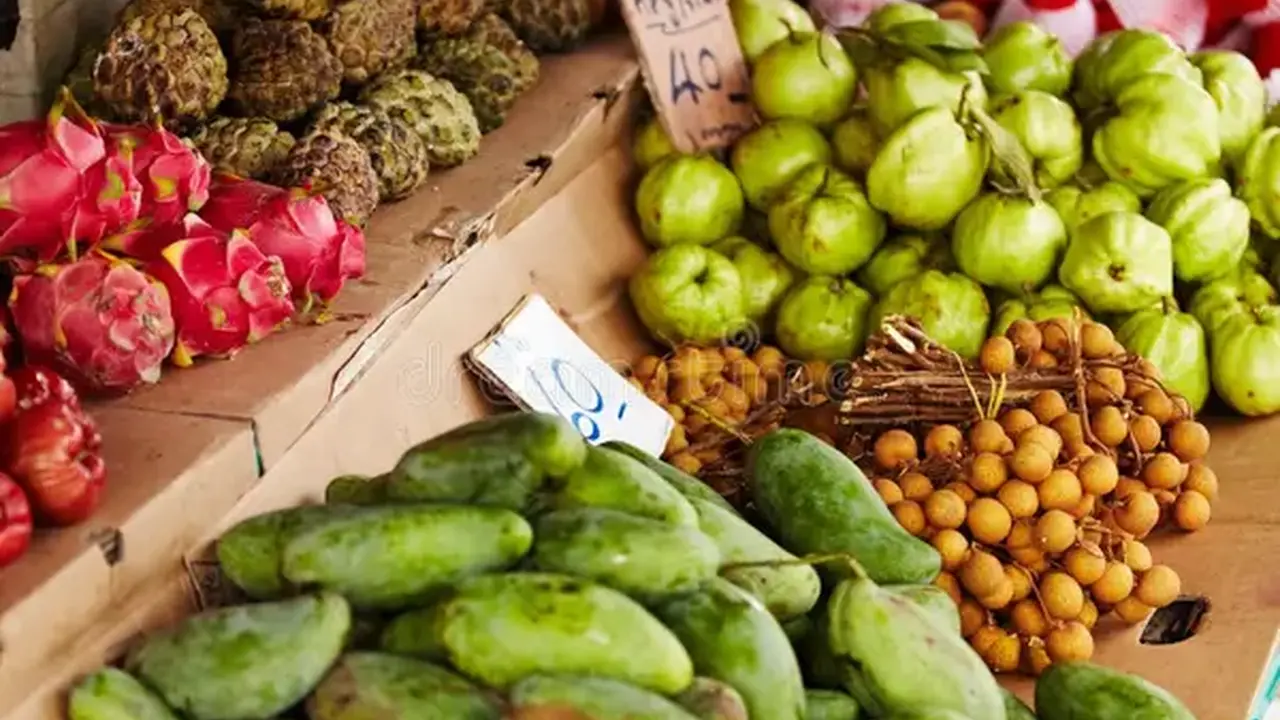Exotic Fruits of Thailand: A Tropical Taste Sensation

Discovering the Delicious Diversity of Thai Fruits A Foodie's Paradise
Thailand, the land of smiles, isn't just famous for its stunning beaches and vibrant culture; it's also a treasure trove of exotic fruits that'll tantalize your taste buds. Forget your everyday apples and bananas; we're talking about fruits you've probably never even heard of, each with its own unique flavor profile and nutritional benefits. Get ready for a tropical fruit adventure!
The Mangosteen The Queen of Fruits and its Health Benefits
The Mangosteen, often dubbed the "Queen of Fruits," is a must-try. Its deep purple rind hides segments of snow-white, juicy flesh that's sweet, tangy, and slightly acidic. It's like a flavor explosion in your mouth! The texture is incredibly smooth and delicate, almost melting on your tongue. This is a fruit that truly lives up to its royal title.
Beyond its delicious taste, the mangosteen is packed with antioxidants, particularly xanthones, which are believed to have anti-inflammatory and anti-cancer properties. It's also a good source of Vitamin C and fiber. So, indulging in a mangosteen is not just a treat; it's a healthy choice too!
Where to find it: Mangosteens are typically in season from May to September. You'll find them piled high at local markets and even at some supermarkets. Look for fruits with a smooth, unblemished rind.
How to eat it: Gently score the rind around the middle with a knife, being careful not to cut into the flesh. Twist off the top half and you'll reveal the juicy segments. Eat the segments directly, avoiding the seeds, which are bitter.
Durian The King of Fruits A Controversial Delight with Unique Flavors
Now, let's talk about the Durian, the "King of Fruits." This one's… polarizing. It's famous (or infamous) for its incredibly strong, pungent odor. Some people describe it as smelling like gym socks, onions, or even sewage. However, those who can get past the smell are rewarded with a creamy, custard-like flesh that's sweet, savory, and incredibly rich. It's a truly unique experience. It is definitely an acquired taste, but if you are brave enough to try it, you might become a convert!
The Durian is a nutritional powerhouse, packed with vitamins, minerals, and fiber. It's also high in calories, so it's best enjoyed in moderation.
Where to find it: Durian season is typically from June to August. You'll find them everywhere – from street vendors to supermarkets. Be warned: some hotels and public transportation systems ban Durian due to its strong smell!
How to eat it: Most vendors will cut open the Durian for you. The flesh is divided into segments. Eat the flesh directly with a spoon. Pro tip: try it with sticky rice for a traditional Thai dessert.
Rambutan A Hairy Delight with Sweet and Tangy Taste
The Rambutan is another eye-catching fruit. It's covered in soft, hair-like spines, giving it a fuzzy appearance. Inside, you'll find a translucent white flesh that's sweet, slightly acidic, and very refreshing. It's similar in taste and texture to a lychee, but with a slightly more tangy flavor.
Rambutans are a good source of Vitamin C and antioxidants.
Where to find it: Rambutan season is typically from May to September. Look for bright red fruits with vibrant green spines.
How to eat it: Cut through the rind around the middle and peel it back. Eat the flesh directly, avoiding the seed, which is bitter.
Mango The Sweet Tropical Staple and its Varieties
Okay, you probably know mangoes, but Thai mangoes are on another level! They're incredibly sweet, juicy, and fragrant. There are many different varieties, each with its own unique flavor profile.
Nam Dok Mai: This is probably the most popular variety. It's long and slender, with a smooth, golden-yellow skin. The flesh is incredibly sweet and juicy, with a melt-in-your-mouth texture. It's perfect for eating on its own or using in desserts like mango sticky rice.
Ok Rong: This variety is smaller and rounder than Nam Dok Mai. It has a slightly firmer texture and a slightly more tart flavor. It's great for salads and smoothies.
Kaew: This variety is green even when ripe. It has a slightly sour and tangy flavor, making it a good choice for dipping in fish sauce or chili powder.
Mangoes are packed with vitamins A and C, as well as fiber and antioxidants.
Where to find it: Mangoes are available year-round in Thailand, but the peak season is from March to June.
How to eat it: Peel the mango and slice the flesh away from the pit. Enjoy it on its own, in a salad, or with sticky rice.
Dragon Fruit A Visually Stunning and Mildly Sweet Treat
Dragon fruit, also known as pitaya, is a visually striking fruit with a vibrant pink or yellow skin and black seeds. The flesh is usually white or pink, and it has a mildly sweet, refreshing flavor. It's not the most intensely flavorful fruit, but it's a great option for a light and healthy snack.
Dragon fruit is a good source of fiber, Vitamin C, and antioxidants.
Where to find it: Dragon fruit is available year-round in Thailand.
How to eat it: Cut the dragon fruit in half and scoop out the flesh with a spoon. You can also peel the skin and slice the flesh.
Specific Product Recommendations and Usage Scenarios Thai Fruit Delights
Let's get specific with some recommended products and how to enjoy them:
Mango Sticky Rice (Khao Niao Mamuang): This is a classic Thai dessert. It's made with sweet sticky rice, fresh mango slices, and a creamy coconut milk sauce. You can find it at almost any street food stall or restaurant in Thailand. Price: 50-100 Baht per serving.
Durian Ice Cream: If you're hesitant to try fresh Durian, Durian ice cream is a good way to ease yourself in. It has a milder flavor and a creamy texture. You can find it at most ice cream shops in Thailand. Price: 30-60 Baht per scoop.
Mangosteen Juice: This is a refreshing and healthy drink made from fresh mangosteens. It's packed with antioxidants and has a sweet and tangy flavor. You can find it at some juice stalls and supermarkets. Price: 40-80 Baht per bottle.
Dried Mango: This is a great snack to take home with you. It's sweet, chewy, and packed with mango flavor. You can find it at most supermarkets and souvenir shops in Thailand. Price: 100-200 Baht per bag.
Comparing Thai Fruits A Flavor and Texture Guide
Here's a quick comparison to help you choose which fruits to try:
- Sweetness: Mango (very sweet), Rambutan (sweet), Mangosteen (sweet and tangy), Dragon Fruit (mildly sweet), Durian (sweet and savory).
- Texture: Mango (juicy and smooth), Rambutan (translucent and slightly firm), Mangosteen (soft and juicy), Dragon Fruit (slightly crunchy), Durian (creamy and custard-like).
- Smell: Mango (fragrant), Rambutan (mild), Mangosteen (mild), Dragon Fruit (mild), Durian (very strong and pungent).
Where to Buy Thai Fruits A Shopper's Guide to Local Markets and Supermarkets
You'll find Thai fruits everywhere in Thailand. Here's a breakdown of where to shop:
- Local Markets: This is the best place to find the freshest and most affordable fruits. You can also haggle for a better price.
- Supermarkets: Supermarkets offer a wider variety of fruits, including imported ones. The prices are usually a bit higher than at local markets.
- Street Vendors: Street vendors sell pre-cut fruits and juices, which is a convenient option for a quick snack.
Enjoying Thai Fruits A Culinary Adventure Awaits
So, there you have it! A whirlwind tour of the exotic fruits of Thailand. Don't be afraid to try something new and step outside your comfort zone. You might just discover your new favorite fruit!
:max_bytes(150000):strip_icc()/277019-baked-pork-chops-with-cream-of-mushroom-soup-DDMFS-beauty-4x3-BG-7505-5762b731cf30447d9cbbbbbf387beafa.jpg)






